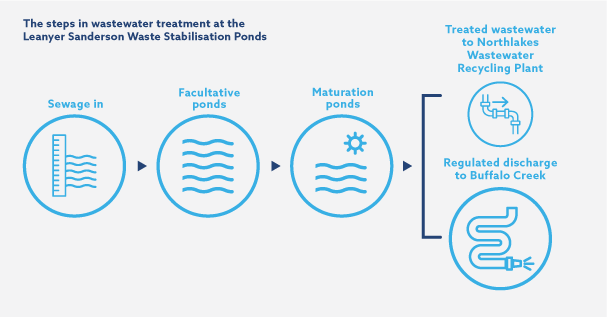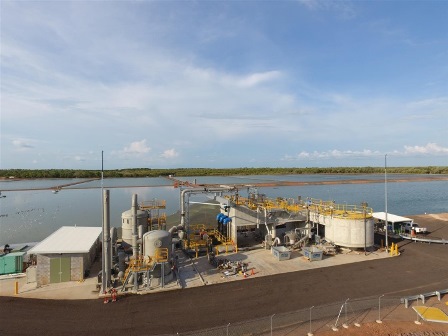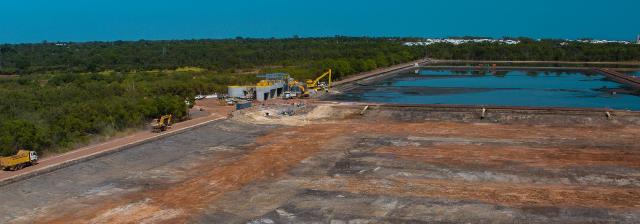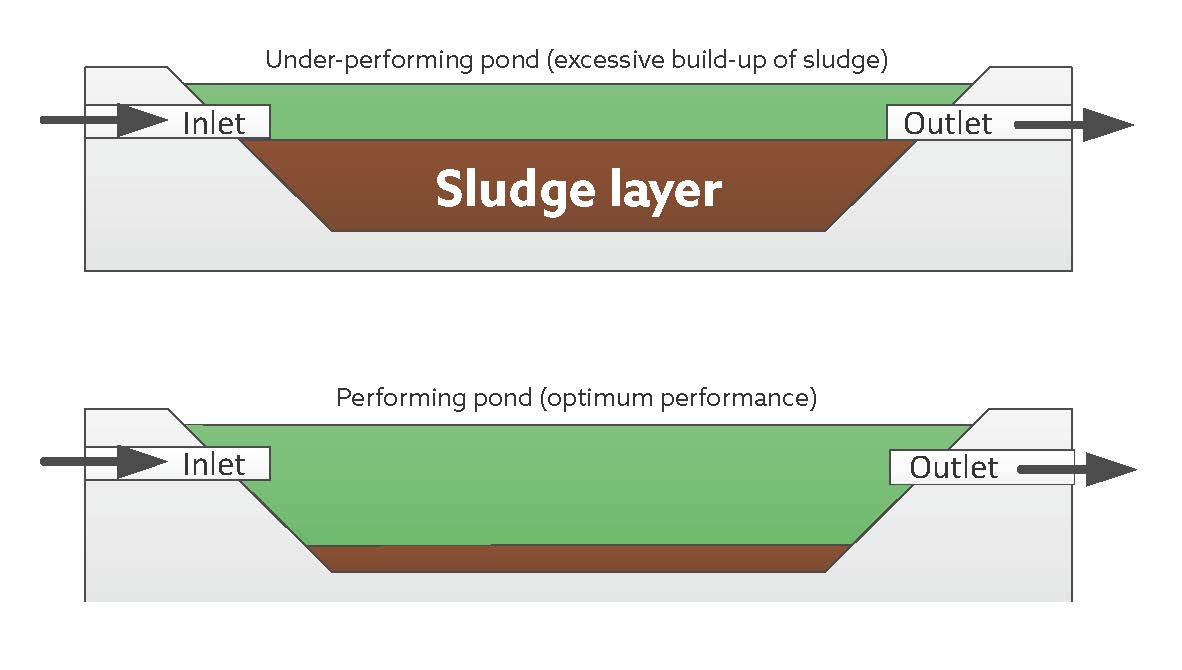About the ponds
The Leanyer Sanderson Waste Stabilisation Ponds have been in operation for more than 40 years.
Wastewater from households, schools, Royal Darwin Hospital and commercial premises across Darwin’s northern suburbs enter a network of pipes that all ultimately lead to the Leanyer Sanderson Waste Stabilisation Ponds.
Wastewater is generally a mixture of waste from toilets, sinks, showers and washing machines. The Leanyer Sanderson Waste Stabilisation Ponds use a cost effective and natural form of treatment that relies on sunlight and bacteria.
Once the wastewater treatment is completed, it either evaporates or, under strict licence conditions issued by the NT Environment Protection Authority (EPA), it is released into Buffalo Creek at a discharge point around seven kilometres upstream from the mouth of the creek.
In the dry season a small amount of the treated water is pumped to the Northlakes Reuse Plant for more treatment before being used for irrigation at the Darwin Golf Course and Marrara sporting ovals.

The Leanyer Waste Stabilisation Ponds:
- collect wastewater from 50,000 Darwin residents
- treat an average of 15 million litres/day of wastewater
- comprise two mirroring pond sets built in 1972
- each pond set has 5 ponds.
Independent Auditors Report
Power and Water Corporation commissioned AECOM, a Victorian EPA Independent Auditor to undertake an Independent Review of the Leanyer Sanderson Waste Stabilisation Ponds. The independent audit process and auditor has been endorsed by the NTEPA.
In response to the report, Power and Water has commenced a Continuous Improvement Program and a number of trials that will improve the quality of water being discharged into Buffalo Creek and reduce the likelihood of odour.
Continuous Improvement Program
Power and Water is always maintaining, repairing and upgrading our wastewater system to protect public health and the environment.
Our Continuous Improvement Program is improving the performance of the Leanyer Sanderson Waste Stabilisation Ponds and generating better outcomes for the environment and the community.
The Continuous Improvement Program is in place to improve the quality of water being discharged into Buffalo Creek from the ponds and reduce the likelihood of odour.
Inlet works upgrade
Construction began in July 2017 to upgrade the inlet works at the Leanyer Sanderson Waste Stabilisation Ponds with the facility being officially opened in December 2018.
The $16.2 million inlet works reduce the environmental impact of treated wastewater that is discharged by removing objects that should not be flushed down the toilet such as wipes, tampons, cotton buds, facial tissues and other rubbish.
The upgrade has:
- improved the performance of the ponds
- reduced environmental impacts on the receiving waters of buffalo Creek by reducing gross pollutants being accidentally discharged to the creek
- improved the management and treatment of odour at the site.

Pond Desludging Works
Part of the facility’s treatment process includes particles settling to the bottom of each pond forming sludge. A build-up of sludge over many years reduces the ponds’ treatment capacity and can lead to poor water discharge quality and odour.
Desludging is a periodic maintenance process where treatment ponds are emptied, dried out and the biosolids are removed from the ponds to increase the efficiency and effectiveness of these facilities.
When the biosolids are dewatered they look much like garden soil.
Sanderson primary pond was taken offline in May 2018 to perform desludging works. Around 25,000 tonnes of sludge was extracted, limed and stored.
Sanderson primary pond was brought back online in November 2018 during the commissioning of the new inlet works.
Desludging of Sanderson ponds 4 and 5 was completed during the 2021 dry season.


Desludging of Sanderson primary pond.
The benefits:
- Desludging coupled with the new Leanyer/Sanderson inlet works will improve discharge water quality.
- Desludging allows the pond to operate at its original designed capacity.
- The risk of odour generated from a pond in normal operation is significantly reduced once the pond is desludged.

Odour mitigation
Odour generation is variable and temporary peaks are anticipated during seasonal weather changes and some stages of the desludging works.
Power and Water is continuing a range of short and medium-term activities to achieve an improved level of odour performance as part of a broader continuous improvement plan associated with the waste stabilisation ponds.
These activities include:
- surface aeration
- chemical and biological additives injection and dosing system trial
- ongoing surface skimming
- optimisation of pumping station cycles to minimise retention times
- tree planting program to create an effective buffer on the perimeter of the waste water treatment facility
- daily site monitoring including additional sampling analysis.
Monitoring at the Leanyer Sanderson Waste Stabilisation Ponds shows that for most of the year odour is contained at the facility. The change of season, temperature variations and heavy monsoonal rain can briefly increase the likelihood of odour.
If you are concerned about odour in the area and wish to register an odour complaint, please register via the reporting form, call 1800 245 092 or email customerservice@powerwater.com.au.
Details that would help our team better understand and manage odour include the:
- exact location where the odour was detected
- date, time of day when it occurred and length of time
- intensity of the odour.

